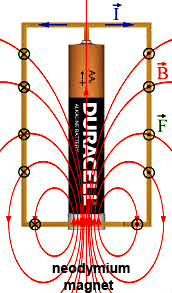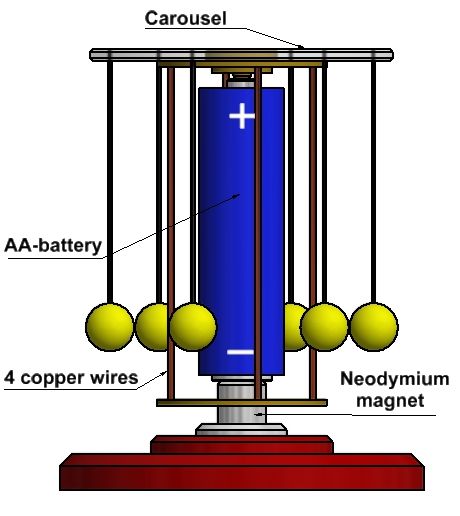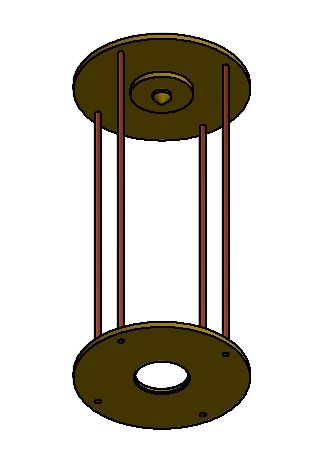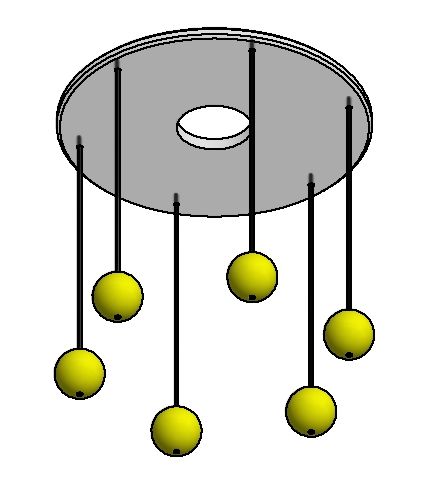The principle.
A so-called "Monopolar motor" is actually the simplest form of a direct current motor. It is more a demonstration of a physical phenomenon on which an electric motor is based than that it has any practical use. Such a monopolar motor consists of only three parts: an AA battery, a neodymium magnet and some wire frame. It is extrmely easy to make without special tools. You can find many examples of this on YouTube, see among other things:
https://www.youtube.com/watch?v=izKvBCaBCpg
The figure below shows schematically how it works.
A 1.5 volt rod battery stands with its negative flat pole on a rod-shaped neodymium magnet. A rectangular copper wire frame has a pointed contact at the top that rests on the positive pole of the battery. The bottom of the wire frame touches the neodymium magnet on the side so that an electric current will flow through the wire frame. This construction also ensures that the wire frame can rotate freely around the longitudinal axis of the battery.
The interaction between the field of the neodymium magnet (B) and the electron current (I) through the wire frame causes a so-called Lorentz force (F) perpendicular to the copper wires, causing the wire frame to rotate.
My version with a carousel.
Almost all monopolar motors that I have seen on You Tube are, with all due respect, very simplistic and often somewhat unstable. I have made a version with a more solid construction and I have also added a merry-go-round carousel to beautify it. The figures below show the design:
Wire frame
Carousel
With this design, the wire frame has 4 copper wires that are soldered to two brass plates. The upper plate has a central point-shaped contact that fits into a conical cavity in the positive pole of the battery, preventing the wire frame from sliding off the battery. I pressed this conical cavity into the plus pole of the battery with a center punch.
The lower brass plate has a central hole with a diameter of 8.2 mm so that it fits with very small clearance over the neodymium magnet with a 8.0 mm diameter. When the wire frame rotates it will also always wiggle somewhat at the point contact in the upper brass plate so that the lower plate actually and always makes a light contact with the neodymium magnet so that an electrical current continues flows through the four copper wires.
This construction also ensures that the center line of the wire frame always coincides with the center line of the battery, so that the rotating movement remains nicely cylindrical and stable.
The carousel consists of a round plexiglass plate containing 6 small holes at 60 degrees in which pieces of sewing thread are glued with plastic beads on the undersides thereof. The plexiglas plate fits slightly clamping on the top copper plate of the wire frame.The battery is in fact short-circuited and there will then be a fairly strong current of approximately 2 amps. The battery also gets slightly warm and after about 10 minutes the motor starts running slower or even stops. If you then let the battery rest for a while, it apparently recovers itself and then the motor runs again, but usually slower and shorter. After a few times the battery is over. It is therefore a battery eater.
I have made the following YouTube video of this very simple but quite funny toy:
A CAD drawing package that I made of this toy is freely available for every enthusiast, click here for a request.



